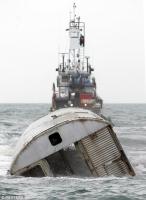
Photo: Stephen Mallon
Redbird Reef lies sixteen miles out in the Atlantic Ocean from the Indian River inlet, near the ominously named Slaughter Beach, Delaware. One of three explanations for the town’s name is that the first postmaster was William Slaughter. Likewise, while many reefs are named after ships that ran up on them, that is not the case with Redbird, which is an artificial reef in around 80 feet of water. The reef is named after the 714 New York City Redbird subway cars that, starting in 2001, were dumped on the generally barren sandy bottom. The cars became home to sponges, blue mussels, sea grasses, as well as flounder, tautog, and black sea bass. The cars were built of steel and painted red, earning their nickname, Redbird. Before dumping, the cars were cleaned of oil and grease and the doors and windows are removed.
Redbird Reef has been a great success, increasing the fish population of the area by 400 times. The only problems encountered have been related to conflicts between fishermen. Commercial pot fishermen keep getting their lines tangled with those of smaller hook-and-reel anglers. In addition to subway cars, 86 retired tanks and armored personnel carriers, eight tugboats and barges, and 3,000 tons of ballasted truck tires have also been dumped on the reef.
Other states have gotten in on subway car reefing. About 95 per cent of the seabed off the U.S. mid-Atlantic coast is naturally bare sand, which is relatively barren of sea life. Now subway car reefs in New Jersey, Virginia, South Carolina and Georgia are providing homes for fish, mollusks, grasses and sponges. After dumping the 1,300 Redbird cars, the New York Metropolitan Transit Authority has moved on to newer stainless steel cars. So far, roughly 2,500 subway cars have been dumped in the Atlantic.
Photographer Stephen Mallon has been documenting a recent round of subway car reef dumps in his project ‘Next Stop Atlantic.’ The images will be on display at New York University’s Kimmel Galleries from February 6th to March 15, 2015.
The subway car reefs have recently provided an unexpected benefit, not to fish, but for oceanographers trying to understand the effect of storms on deeper waters. Hurricane Irene in 2011 and Hurricane Sandy in 2012 generated large enough waves to rearrange and in some cases to crush subway cars on the Redbird Reef eighty feet below the ocean surface. By analyzing the patterns of how the reef has been rearranged, scientists can get a better idea of the power and characteristics of the major storm waves.
Visualization of Hurricane Sandy Damage at Redbird Artificial Reef
Thanks to Alaric Bond for contributing to the post.

Pingback: Metro New York naar de zeebodem | Bootjesgek.nl
Pingback: Phasernet.net » Blog Archive » Redbird Reef — Subway Cars, Fish and Hurricanes